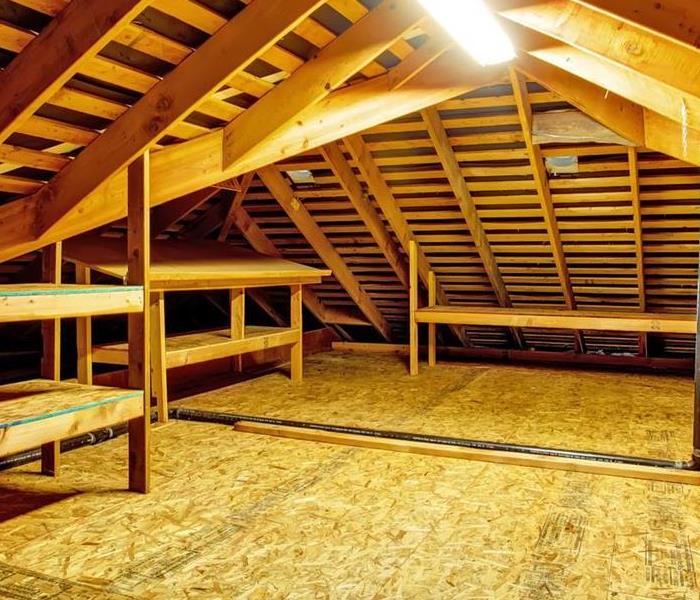Prevent Water In Your Attic This Summer
6/19/2020 (Permalink)
Water and moisture in your attic can cause you headaches and costly repairs. Mold can grow and compromise your health, and water can weaken the structural integrity of your home. Most of the time, attic water damage is caused by a roof leakage. Other times, it may be improper attic ventilation and insulation or appliance failures. Here’s how to prevent roof leakage and water damage from ventilation, insulation, or appliances in your attic.
How to Prevent Roof Leakage
The best tip on how to prevent roof leakage is to maintain it regularly:
- Trim your trees to prevent dead limbs falling on your roof
- Clear the roof of any twigs, leaves, and other debris
- Check and clean the gutters and downspouts to ensure they are draining properly
- Have a roofing contractor inspect your roof regularly
A professional roofing contractor can check the roof’s integrity and spot and fix missing shingles, warping, corrosion, or any other issue, in time to prevent roof leakage.
Tips to Find and Repair a Roof Leakage
First, check the insulation and wood for signs of water damage, such as discoloration and mold growth. The area where the two roofs join at an angle is prone to cracks and roof leaks, so make sure to inspect it as well.
Leaks are also common in the area around attic plumbing stacks. Another way to detect water leaks in the attic is to inspect the recessed lighting canisters. Rust, corrosion, and stains around them indicate moisture coming from the attic and possible electrical dangers.
If you see these signs, check and fix these issues: worn moisture barriers, deteriorated shingles or pipe flashing, missing flashing, caps or shingles, or clogged gutters and downspouts. Check out more tips to repair a roof leak.
Ventilate Your Attic
Besides learning how to prevent roof leakage, ensure your attic is properly ventilated. Without correct ventilation, the moisture in your attic increases. Having good attic ventilation is especially important in winter. That’s because, in winter, warm air rises to the ceiling, enters the attic, and condenses on the cold surfaces of the attic. Condensation can’t escape unless your attic has adequate ventilation.
Additionally, make sure your attic vents — soffit, ridge, and gable-mounted vents — openings are not blocked by something like insulation. There are many ways to improve attic ventilation, so be sure to consult a specialist.
Insulate Your Attic
Insulation plays an important role in controlling the temperature levels in your attic. In winter, the attic temperature should be five to ten degrees warmer than the outside. Otherwise, ice dams may form on the edges of your roof, potentially causing water damage.
So, make sure your attic floor is properly insulated to help prevent warm air from entering the attic. In addition, ensure the insulation of heating ducts are also in good shape.
To check if your insulation is in good condition, ensure it’s thick, soft, and dry. If it feels moist and looks thin and flat, it will create high moisture conditions. Replace it immediately.
Vent Appliances to the Outside
A common mistake in homes is improper ventilation of appliances. The dryer, kitchen, and bathroom vents should always blow the air to the outside and not in the attic. Your attic ventilation may not otherwise be able to eliminate the accumulated moisture efficiently.
Maintain Attic Appliances
Note that appliances in your attic such as air conditioners, swamp coolers, and HVAC systems may fail and cause water damage. During your attic inspection, check these appliances for wear and tear and loose connections.
Now that you know how to prevent roof leakage and attic water damage, learn how to avoid other types of water damage in your home. As ventilation is important in the entire house, check out more home ventilation tips and how to control the humidity in your home.
For water removal services and mold cleaning services, contact SERVPRO of Lynn/Lynnfield at 781.593.6663.





 24/7 Emergency Service
24/7 Emergency Service
